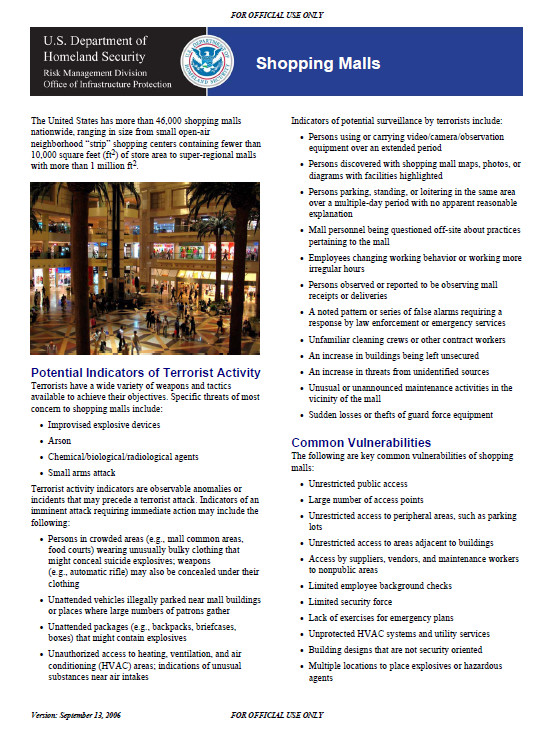 Risk Management Division
Risk Management Division
- 2 pages
- For Official Use Only
- September 13, 2006
The United States has more than 46,000 shopping malls nationwide, ranging in size from small open-air neighborhood “strip” shopping centers containing fewer than 10,000 square feet (ft2) of store area to super-regional malls with more than 1 million ft2.
Terrorist activity indicators are observable anomalies or incidents that may precede a terrorist attack. Indicators of an imminent attack requiring immediate action may include the following:
• Persons in crowded areas (e.g., mall common areas, food courts) wearing unusually bulky clothing that might conceal suicide explosives; weapons (e.g., automatic rifle) may also be concealed under their clothing
• Unattended vehicles illegally parked near mall buildings or places where large numbers of patrons gather
• Unattended packages (e.g., backpacks, briefcases, boxes) that might contain explosives
• Unauthorized access to heating, ventilation, and air conditioning (HVAC) areas; indications of unusual substances near air intakes
Indicators of potential surveillance by terrorists include:
• Persons using or carrying video/camera/observation equipment over an extended period
• Persons discovered with shopping mall maps, photos, or diagrams with facilities highlighted
• Persons parking, standing, or loitering in the same area over a multiple-day period with no apparent reasonable explanation
• Mall personnel being questioned off-site about practices pertaining to the mall
• Employees changing working behavior or working more irregular hours
• Persons observed or reported to be observing mall receipts or deliveries
• A noted pattern or series of false alarms requiring a response by law enforcement or emergency services
• Unfamiliar cleaning crews or other contract workers
• An increase in buildings being left unsecured
• An increase in threats from unidentified sources
• Unusual or unannounced maintenance activities in the vicinity of the mall
• Sudden losses or thefts of guard force equipment
